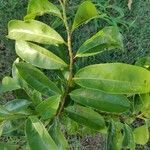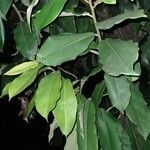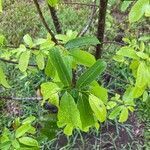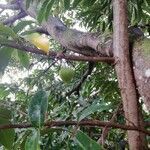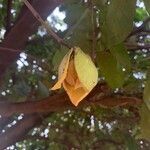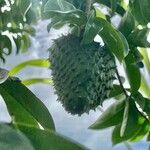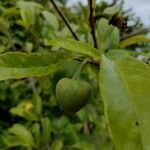Trees to 10 m tall, evergreen. Bark purplish brown. Branchlets green and smooth when young. Petiole 1.2-2 cm, adaxially grooved; leaf blade elliptic, papery, abaxially smooth and pale green, adaxially light to dark green, secondary veins 11-16 on each side of midvein, basally punctate, and adaxially slightly concave, base cuneate, apex shortly acuminate. Inflorescences terminal or axillary on apical branchlets, 1-or 2-flowered. Pedicel 2.5-4 cm, robust. Sepals ovate, ca. 6 mm. Outer petals yellowish brown, broadly ovate, apex acute; inner petals orange, shorter than outer petals, apex obtuse. Stamens many; filaments white, flat; anther locules brown; connectives apically dilated. Carpels oblong, 6-7 mm, free at anthesis; ovaries pubescent. Syncarp brownish yellow, ovoid, subglobose, or cordate-ovoid, slightly oblique, 9.5-14 × 9.5-12.5 cm, with dense soft prickles and dark brown hairs; pulp yellowish, aromatic. Fl. May-Jun, fr. Jul-Sep.
More
A small deciduous tree. It grows 5-8 m high. It can be 15 m high. It has a dense covering of leaves. The leaves are simple and oval. They are 25 cm long by 8 cm wide. The flowers are large and occur singly. They are yellow. They grow on the trunk and main branches. The fruit are large and green. They have a network appearance on the surface. The fruit is 25 cm long by 15 cm wide. It has oval seeds. They are 1.5 cm long.
It is a tropical plant. It can stand temperatures several degrees below freezing. It is cultivated between 100-200 m altitude in southern China. In Colombia it grows between 60-120 m above sea level. In Brisbane Botanical Gardens. In XTBG Yunnan. It suits hardiness zones 10-11. It needs a fertile, well drained soil.
More
Usually along the sides of streams in mountainous areas, but sometimes descending to near sea level.
